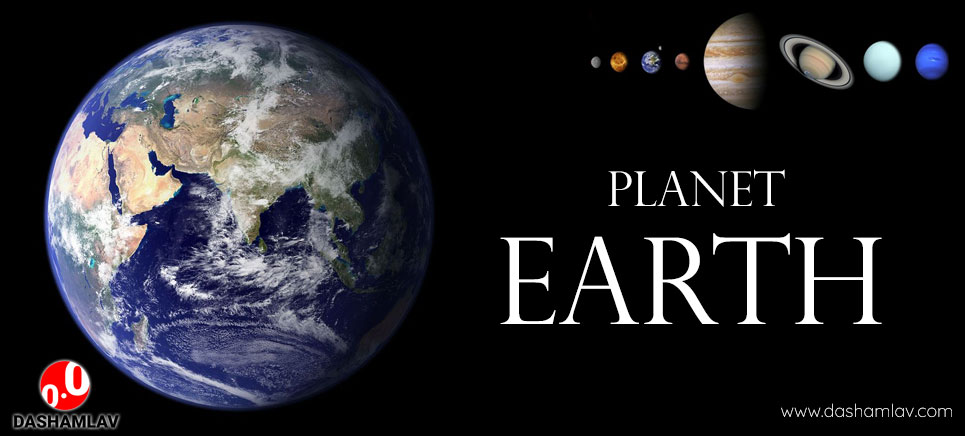Earth is our home — the only home we so far. We live and die on this almost spherical planet that keeps orbiting its star, the Sun. We remain so busy in our lives that we hardly think about how amazing it our planet. So, today we are going to tell you a number of interesting facts about the planet Earth. These facts will help you appreciate the magic of life even more!
- How old is the Earth?
We should of course begin with the question of Earth’s age. How long ago did this planet came into existence? Well, scientists believe that Earth was formed about 4.54 billion years ago. The oldest rocks on Earth are in Nuvvuagittuq Greenstone Belt in Northern Quebec, Canada. These metamorphic rocks are estimated to be 3.7 to 4.3 billion years old! - Earth in Solar System
Earth is the third planet in the solar system. Mercury and Venus are closer to Sun than our planet. Earth is a rocky (terrestrial) planet which has an atmosphere filled with oxygen, among other gases. Oxygen is one of the key reasons behind sustainable of advanced life on Earth. - Size and weight of the Earth
At equator the Earth’s diameter is 12,756 km (7,926 miles) and circumference is 40,075 km (24,901 miles). Equator, as we know, is an imaginary line that divides the planet in two equal halves. Close to 78.8% of Equator passes across water and 21.3% over the land. Earth’s mass is about 6,000,000,000, 000,000,000,000,000 kilograms (6 x 1024 kilograms, or 1.3 x 1025 pounds). - Twin Planet of Earth
Venus is considered to be the Twin Planet of Earth because both Earth and Venus have same mass and similar size. They are neighbors and their composition is also similar.

- Earthquakes
When the tectonic plates under the Earth’s surface move and create friction with each other, the ground shakes violently. This phenomenon is called the Earthquake (or shaking of the Earth). The biggest earthquake happened in Chile on 22 May 1960. This massive earthquake was measured to be 9.5 on richter scale. - Temperature of the Earth
Earth receives unequal amount of heat at different places from the Sun. While polar regions are icy cold, the countries on or near the Equator generally are hotter places on the Earth. The highest natural temperature ever recorded on Earth’s surface was 57.8 °C (136.0 °F) on 11 July 1909 in Cherokee, Oklahoma, United States. The lowest natural temperature ever recorded on Earth’s ground is -89.2 °C (-128.6 °F). It was recorded on 21 July 1983 at the Soviet Vostok Station in Antarctica. - Highest Point on Earth
If we measure from the sea level, Mount Everest is the highest point on Earth. The Sagarmatha, as it is locally known as, is 29,029 feet (8,848 meters) high. However, if we measure from the base of the mountain, Mauna Kea is about 10,200 meters (33,464.6 ft) high. - Deepest Point on Earth
Mariana Trench in the western Pacific Ocean is the deepest point on planet Earth. This trench goes as deep as 10,984 meter (36,037 ft). If we talk about lowest point on land — it would be the Dead Sea, located between Jordan, Israel and the West Bank. The surface of Dead Sea is 423 meters (1,388 ft) below the sea level. - Land and Water on Earth
There are seven continents on Earth: Asia, Africa, North America, South America, Antarctica, Europe, and Australia. However, 70% of the planet Earth is covered with five water oceans, namely Atlantic, Pacific, Indian, Arctic and Southern (Antarctic). About 335 million years ago, there was only one super-continent called Pangaea and one super-ocean called Panthalassa. The Pangaea began to break into pieces 175 million years ago and these pieces began to drift apart to form the current configuration of land mass of the Earth. - Chemical Composition of Earth
Oxygen is the most abundant element in rocks in Earth’s crust, composing roughly 47 percent of the weight of all rock. The second most abundant element is Silicon (27%), followed by Aluminum (8%), Iron (5%), Calcium (4%), and Sodium, Potassium and Magnesium (2% each). Earth’s core composed mostly of Iron and Nickel.
Statistics about Planet Earth
| Property | Value |
|---|---|
| Earth’s circumference | 40075.017 km (24901.461 miles) at the Equator |
| Earth’s radius | 6378.1 km (3963.2 miles) at the Equator |
| Earth’s surface area | 510,072,000 km2 (196940000 sq miles) 148,940,000 km2 land (57510000 sq miles; 29.2%) 361,132,000 km2 water (139434000 sq miles; 70.8%) |
| Earth’s volume | 1.08321 × 1012 km3 (2.59876×1011 cubic miles) |
| Earth’s mass | 5.97237 × 1024 kg |
| Mean density | 5.514 g/cm3 |
| Average distance from the Sun | 149,598,262 km (92,956,050 miles) |
| Perihelion (closest approach to the Sun) | 147,098,291 km (91,402,640 miles) |
| Aphelion (farthest distance from the Sun) | 152,098,233 km (94,509,460 miles) |
| Length of solar day (single rotation on its axis) | 23.934 hours |
| Length of year (single revolution around the Sun) | 365.26 days |
| Equatorial inclination to orbit (axial tilt) | 23.4393 degrees |
| Rotation speed at Equator | 0.4651 km/s (1674.4 km/h; 1040.4 mph) |
| Surface gravity | 9.80665 m/s2 |
| Escape velocity | 11.186 km/s |
| Natural satellite | Moon |
| Earth’s composition | Iron (32.1%) Oxygen (30.1%) Silicon (15.1%) Magnesium (13.9%) Sulphur (2.9%) Nickel (1.8%) Calcium (1.5%) Aluminum (1.4%) Other elements (1.2%) |
| Atmospheric composition | Nitrogen (78.08%) Oxygen (20.95%) Argon (0.9340%) Carbon dioxide (0.0408%) Neon (0.00182%) Helium (0.00052%) Methane (0.00017%) Krypton (0.00011%) Hydrogen (0.00006%) |
Use the citation below to add this article to your bibliography
"Planet Earth: Interesting Facts about Our Planet." Dashamlav.com. Web. 9 May 2025. <https://dashamlav.com/planet-earth-facts/>
Dashamlav.com, "Planet Earth: Interesting Facts about Our Planet." Accessed 9 May 2025. https://dashamlav.com/planet-earth-facts/
"Planet Earth: Interesting Facts about Our Planet." (n.d.). Dashamlav.com. Retrieved 9 May 2025 from https://dashamlav.com/planet-earth-facts/
